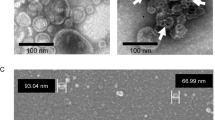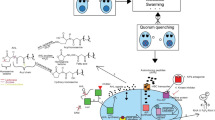Abstract
Pyoverdines (PVD) are a group of siderophores produced by fluorescent Pseudomonads. Identification of PVD variants mostly relies on liquid chromatography-tandem mass spectrometry (LC–MS/MS) using collision-induced dissociation (CID). Here, both CID and the novel dissociation technique electron-capture dissociation (ECD) were applied to characterize PVD succinamide and its Fe(III)-chelated complex. The results clearly showed that ECD produced diagnostic side chain fragmentation of the PVD peptide chain and preserved the labile Fe(III) binding to the chromophore in contrast to CID. The ECD technique is therefore expected to support the understanding of strain-specific Fe(III) transport processes of PVDs.





Similar content being viewed by others
References
Budnik BA, Haselmann KF, Zubarev RA (2001) Electron detachment dissociation of peptide di-anions: an electron-hole recombination phenomenon. Chem Phys Lett 342:299–302
Caravatti P, Allemann M (1991) The ‘infinity cell’: a new trapped-ion cell with radiofrequency covered trapping electrodes for fourier transform ion cyclotron resonance mass spectrometry. Org Mass Spectrom 26:514–518
Coon J, Shabanowitz J, Hunt D, Syka JP (2005) Electron transfer dissociation of peptide anions. J Am Soc Mass Spectrom 16:880–882
Fuchs R, Budzikiewicz H (2001) Rearrangement reactions in the electrospray ionization mass spectra of pyoverdins. Int J Mass Spectrom 210–211:603–612
Hannauer M et al (2012) Biosynthesis of the pyoverdine siderophore of Pseudomonas aeruginosa involves precursors with a myristic or a myristoleic acid chain. FEBS Lett 586:96–101
Hider RC, Kong X (2010) Chemistry and biology of siderophores. Nat Prod Rep 27:637–657
Kaczorowska M, Cooper H (2010) Electron induced dissociation: a mass spectrometry technique for the structural analysis of trinuclear oxo-centred carboxylate-bridged iron complexes. J Am Soc Mass Spectrom 21:1398–1403
Leslie A, Daneshfar R, Volmer DA (2007) Infrared multiphoton dissociation of the siderophore enterobactin and its Fe(III) complex. Influence of Fe(III) binding on dissociation kinetics and relative energetics. J Am Soc Mass Spectrom 18:632–641
Leymarie N, Costello CE, O’Connor PB (2003) Electron capture dissociation initiates a free radical reaction cascade. J Am Chem Soc 125:8949–8958
Little DP, Speir JP, Senko MW, O’Connor PB, McLafferty FW (1994) Infrared multiphoton dissociation of large multiply charged ions for biomolecule sequencing. Anal Chem 66:2809–2815
Liu H, Håkansson K, Lee JY, Sherman DH (2007) Collision-activated dissociation, infrared multiphoton dissociation, and electron capture dissociation of the Bacillus anthracis siderophore petrobactin and its metal ion complexes. J Am Soc Mass Spectrom 18:842–849
Meyer J-M, Geoffroy VA, Baysse C, Cornelis P, Barelmann I, Taraz K, Budzikiewicz H (2002) Siderophore-mediated iron uptake in fluorescent Pseudomonas: characterization of the pyoverdine-receptor binding site of three cross-reacting pyoverdines. Arch Biochem Biophys 397:179–183
Meyer J-M, Gruffaz C, Raharinosy V, Bezverbnaya I, Schäfer M, Budzikiewicz H (2008) Siderotyping of fluorescent Pseudomonas: molecular mass determination by mass spectrometry as a powerful pyoverdine siderotyping method. Biometals 21:259–271
Mohn G, Koehl P, Budzikiewicz H, Lefevre J-F (1994) Solution Structure of Pyoverdin GM-II. Biochem (Mosc) 33:2843–2851
Mosely JA, Smith MJP, Prakash AS, Sims M, Bristow AWT (2011) Electron-induced dissociation of singly charged organic cations as a tool for structural characterization of pharmaceutical type molecules. Anal Chem 83:4068–4075
Pluháček T, Lemr K, Ghosh D, Milde D, Novák J, Havlíček V (2015) Characterization of microbial siderophores by mass spectrometry Mass Spectrom Rev.doi:10.1002/mas.21461
Qi Y, O’Connor PB (2014) Data processing in Fourier transform ion cyclotron resonance mass spectrometry. Mass Spectrom Rev 33:333–352
Qi Y, Volmer DA (2015a) Electron-capture dissociation for investigating host/guest complexes of 18-crown-6-ether and peptides. Rapid Commun Mass Spectrom 29:2316–2318
Qi Y, Volmer DA (2015b) Electron-based fragmentation methods in mass spectrometry: An overview. Mass Spectrom Rev. doi:10.1002/mas.21482
Qi Y, Liu Z, Li H, Sadler PJ, O’Connor PB (2013) Mapping the protein-binding sites for novel iridium(III) anticancer complexes using electron capture dissociation. Rapid Commun Mass Spectrom 27:2028–2032
Qi Y, Bortoli S, Volmer DA (2014) Detailed study of cyanobacterial microcystins using high performance tandem mass spectrometry. J Am Soc Mass Spectrom 25:1253–1262
Qi Y, Geib T, Volmer DA (2015) Determining the binding sites of β-cyclodextrin and peptides by electron-capture dissociation high resolution tandem mass spectrometry. J Am Soc Mass Spectrom 26:1143–1149
Roepstorff P, Fohlman J (1984) Proposal for a common nomenclature for sequence ions in mass spectra of peptides. Biomed Mass Spectrom 11:601
Sarbu M, Ghiulai R, Zamfir A (2014) Recent developments and applications of electron transfer dissociation mass spectrometry in proteomics. Amino Acids 46:1625–1634
Schäfer M, Fuchs R, Budzikiewicz H, Springer A, Meyer J-M, Linscheid M (2006) Structure elucidation of cyclic pyoverdins and examination of rearrangement reactions in MS/MS experiments by determination of exact product ion masses. J Mass Spectrom 41:1162–1170
Schalk IJ, Guillon L (2013) Pyoverdine biosynthesis and secretion in Pseudomonas aeruginosa: implications for metal homeostasis. Environ Microbiol 15:1661–1673
Sleno L, Volmer DA (2004) Ion activation methods for tandem mass spectrometry J Mass Spectrom 39:1091–1112
Teintze M, Hossain MB, Barnes CL, Leong J, Van der Helm D (1981) Structure of ferric pseudobactin: a siderophore from a plant growth promoting Pseudomonas. Biochemistry (Mosc) 20:6446–6457
Wei H, Aristilde L (2015) Structural characterization of multiple pyoverdines secreted by two Pseudomonas strains using liquid chromatography-high resolution tandem mass spectrometry with varying dissociation energies. Anal Bioanal Chem 407:4629–4638
Wills RH, Tosin M, O’Connor PB (2012) Structural characterization of polyketides using high mass accuracy tandem mass spectrometry. Anal Chem 84:8863–8870
Ye L et al (2013) A combinatorial approach to the structure elucidation of a pyoverdine siderophore produced by a Pseudomonas putida isolate and the use of pyoverdine as a taxonomic marker for typing P. putida subspecies. Biometals 26:561–575
Zubarev RA, Kelleher NL, McLafferty FW (1998) Electron capture dissociation of multiply charged protein cations—a nonergodic process. J Am Chem Soc 120:3265–3266
Zubarev RA et al (2000) Electron capture dissociation for structural characterization of multiply charged protein cations. Anal Chem 72:563–573
Acknowledgments
DAV acknowledges general research support by the Alfried Krupp von Bohlen und Halbach-Stiftung. This work was supported in part by the DFG FTICR-MS Facility, INST 256/356-1.
Author information
Authors and Affiliations
Corresponding author
Electronic supplementary material
Below is the link to the electronic supplementary material.
Rights and permissions
About this article
Cite this article
Qi, Y., Hayen, H. & Volmer, D.A. Characterization of the iron-binding properties of pyoverdine using electron-capture dissociation-tandem mass spectrometry. Biometals 29, 53–60 (2016). https://doi.org/10.1007/s10534-015-9895-z
Received:
Accepted:
Published:
Issue Date:
DOI: https://doi.org/10.1007/s10534-015-9895-z




